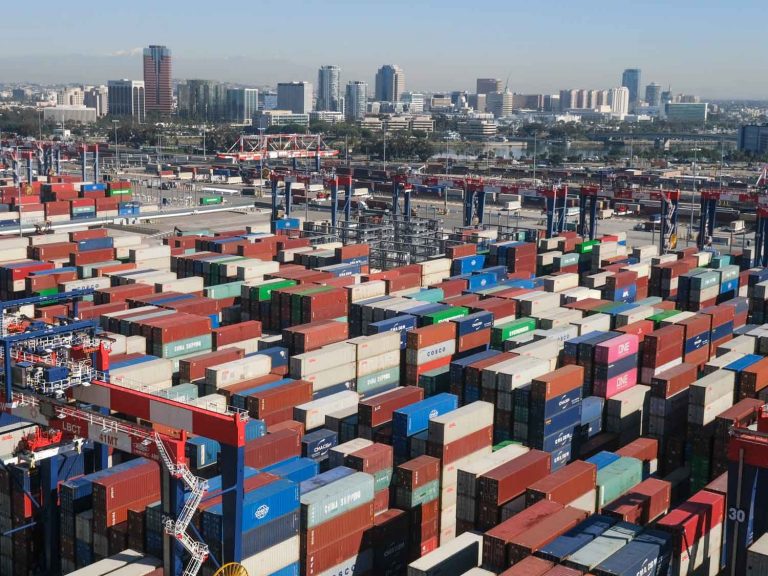
Date:
US supply chains face multiple threats
Importers are entering a critical period, with looming labour disputes, capacity pressures, and surges in maritime and airfreight volumes are creating challenges that could disrupt supply chains well into the fourth quarter.
Demand surge
The Port of Los Angeles handled a record-breaking 940k TEU in July, up 37% YoY, with the US’ largest container gateway 18% ahead of 2023 volumes.
US imports from Asia have been climbing for 10 consecutive months, with no sign of slowing down. A surge in import volumes is expected in August as businesses have been front-loading shipments ahead of a potential ILA strike.
Analysts had originally predicted a tapering of imports during the traditional peak season from August to October, but the market is now expecting year-over-year increases in monthly imports through the end of 2024.
The increase in trans-Atlantic import volumes has not completely eased pressure for space, with a 7% growth in volume during H1 2024 and the container shipping lines announcing peak season surcharges (PSS) for 1st September.
Ocean capacity
Since early July, capacity constraints on the West Coast have begun to ease, thanks to the launch and reintroduction of at least ten services. This shift has widened the rate differential between East and West coast ports, with East Coast rates now nearly 50% higher, the largest gap seen since October 2022.
However, East Coast spot rates may soften in the latter half of August if demand drops, because importers have been front-loading shipments to leave Asia in time for Black Friday sales and to avoid disruption posed by a looming strike. The International Longshoremen’s Association (ILA) contract with East and Gulf Coast maritime employers is set to expire on 30th September, and nothing has been agreed to take its place.
ILA strike
The potential for an ILA strike has become a major concern for the shipping industry. The ILA is demanding a nearly 80% wage increase over the next six years, a proposal that maritime employers have yet to agree upon.
With the union issuing a 60-day strike notice, the possibility of industrial action is growing, with ILA locals from the East and Gulf coasts expected to meet early September to finalise strike strategies. ILA President Harold Daggett has made it clear that members will not continue working beyond the contract’s expiration if their demands are not met.
Canadian rail strike
Canada faces potential industrial action at its two main freight rail companies, Canadian National Railway (CN) and Canadian Pacific Kansas City (CPKC), starting Thursday 22nd August. Both companies plan to lock out union workers due to stalled labour negotiations.
The Teamsters union has issued strike notices, and without last-minute agreements, a work stoppage is expected. US operations will continue.
From 20th August, CPKC has said it will stop all shipments that start in Canada and all shipments originating in the US that are headed for Canada, while CN, meanwhile, has barred container imports from US partner railroads.
Both rail companies have said that their trains running in the US will continue to work.
The shutdown will disrupt freight movements to and from the West Coast ports of Vancouver and Prince Rupert. Contingency plans include using long-haul trucks or rerouting cargo through US railroads via Seattle.
Airfreight pressure
If port strikes do occur, they will inevitably spill over into the airfreight sector, leading to a significant spike in demand. However, with airfreight is already under massive pressure from heightened eCommerce activity driven by platforms like Shein and Temu.
Shein alone now accounts for about 20% of global fast-fashion sales, filling 50 to 80 freighter aircraft daily with shipments from China to the US.
An ILA strike would likely exacerbate these capacity constraints, as “distressed” ocean cargo seeks expedited transport, further tightening airfreight capacity. Rates are already surging, with trans-Pacific spot rates up 70% year over year, levels typically seen during Q4 and carriers considering peak season surcharges at the beginning of September.
With all these factors in play, Q4 is shaping up to be a challenging period for US supply chains. If you have any concerns about these potential disruptions, we are available to review your situation, explore your options, and develop contingency plans where necessary.
To learn how we can support your trade with the United States or for more information about our ocean solutions, please EMAIL our Chief Commercial Officer, Andy Smith.
